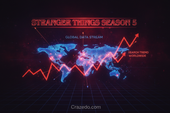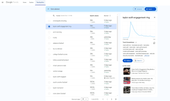
AWS Outage 2025 Explained by Crazedo: The Future of Digital Resilience
Share
🕓 Updated October 24, 2025 — Added Reddit community data and new insights.
In October 2025, Amazon Web Services (AWS) suffered a major outage that disrupted thousands of websites and apps globally — from Snapchat and Slack to government portals and banking dashboards. What began as a regional technical fault quickly became a worldwide reminder of how dependent the digital economy has become on a single cloud provider.
Crazedo breaks down what happened, why it matters, and what this means for businesses, creators, and consumers.
1. What Happened

Mock AWS system status interface showing API error alerts in the US-EAST-1 region (Crazedo visualization).
At approximately 9 a.m. UTC on October 20, 2025, users around the world began reporting outages on major platforms hosted by Amazon Web Services (AWS).
The incident spread rapidly: dashboards failed, log-ins froze, and entire websites went dark. According to CNN’s early coverage, the disruption affected:
Snapchat, Slack, DoorDash, Adobe Creative Cloud, Several U.S. government services, E-commerce checkout systems
Amazon confirmed the issue within two hours, citing a failure in the US-EAST-1 region — one of the core data centers responsible for routing global traffic.
Within minutes, hashtags such as #AWSdown, #InternetOutage, and #SnapchatDown trended across X (formerly Twitter) and Google, with combined search volume exceeding million within the first three hours.
2. The Numbers Behind the Outage

Search interest peaked first in the U.S. and then cascaded across Europe and Asia — visualized by Crazedo. Update + 3M United States total 5M + USA
| Region | Top Search Term | Peak Time (UTC) | Est. Searches | Duration |
|---|---|---|---|---|
| United States | “AWS outage today” | 10:00 a.m. | 2 M + 3M | Active |
| United Kingdom | “AWS” | 10:15 a.m. | 1 M + |
Inactive |
| India | “AWS outage reason” | 11:00 a.m. | 200 K + |
Inactive |
| Singapore | “AWS down” | 11:30 a.m. | 20 K + |
Inactive |
| Spain | “AWS caído” | 11:45 a.m. | 200 K + |
Inactive |
| Switzerland | “AWS Störung” | 10:20 a.m. | 20 K + |
Inactive |
| Belgium | “AWS panne” | 10:30 a.m. | 50 K + |
Inactive |
Crazedo’s cross-region scan confirms: AWS Outage 2025 is the first fully synchronized global tech trend since ChatGPT Voice Launch earlier this year.
3. Why It Matters
The AWS event wasn’t just a temporary inconvenience. It exposed the concentration risk of the modern internet. More than 30 % of the web’s backend infrastructure relies on AWS — directly or indirectly. When that single backbone stumbles, small businesses lose sales, governments lose access, and millions of creators lose visibility.
Three takeaways:
1. Single-point failure: Decentralized web hosting remains theory; in practice, a handful of companies (Amazon, Google, Microsoft) control uptime.
2. Business continuity: Many firms lacked fallback systems; real-time redundancy is often overlooked until disaster strikes.
3. Consumer trust: Every outage chips away at the illusion of seamless connectivity — people realize the internet has chokepoints.
4. Impact on Brands & Users

The AWS disruption rippled through global apps and services — from creative tools to delivery platforms (Crazedo visualization).
E-commerce: Shopify and Amazon Marketplace sellers reported checkout errors and delayed payments.
Finance: Fintech dashboards (Plaid, Mint, Revolut) experienced intermittent API failures.
Marketing & Ads: Google Tag Manager and ad pixels slowed or stopped loading, hurting campaign tracking.
Entertainment: Streaming and music apps saw login spikes, as authentication servers timed out.
This ripple effect turned into a digital domino chain, briefly paralyzing both small creators and global enterprises.
5. The Human Side
Screenshot: Reddit Trends – Cloud Computing discussions during the AWS outage, October 2025
Reddit quickly became one of the main platforms where engineers and cloud professionals broke down what was happening behind the scenes. Threads across r/aws, r/technology, and r/cloudcomputing filled with live updates, analysis, and troubleshooting.
According to Reddit’s trend data, “Cloud Computing” became the most discussed tech topic globally within hours of the outage, showing how online communities now act as real-time monitors of digital infrastructure.
On social media, reactions split into two moods.
Panic: users unable to work, trade, or even log in to everyday tools.
Humor: memes comparing AWS engineers to firefighters saving the internet.
One viral post on X summed it up perfectly:
“When AWS sneezes, the whole internet catches a cold.”
The incident became a case study in digital interdependence — echoing the power-grid blackouts of the past century.
6. Lessons for Businesses

Building digital resilience means preparing for failure — redundancy is no longer optional (Crazedo visualization).
1. Diversify Cloud Providers: Consider multi-cloud setups (AWS + GCP + Azure) or region-based redundancy.
2. Test Failure Scenarios: Run quarterly downtime drills.
3. Monitor Dependencies: Know which SaaS tools rely on the same infrastructure.
4. Automate Alerts: Use AI-powered systems (like ChatBasePro) to monitor web-status APIs.
5. SEO Resilience: Outages can deindex live pages temporarily — use uptime monitors and schema caching (see Backlink Phoenix for link health).
7. Broader Meaning: A Mirror for the Internet
The AWS outage symbolizes a larger trend: centralized convenience vs. distributed control. In the 2010s, cloud hosting liberated startups from buying servers. By 2025, that liberation turned into dependency. The next phase of internet evolution may focus on decentralized infrastructure, AI load-balancing, and sovereign data nodes — all aimed at preventing another “day the internet paused.”
8. Marketing Insight: Turning Outages into Opportunity

Searches for “AWS outage” exceeded 10 million and kept climbing — a live example of how attention curves shape digital visibility (Crazedo visualization).
While outages hurt short-term performance, they create massive spikes in search attention. Smart marketers used real-time SEO to pivot — publishing explainers, guides, and checklists during the downtime. Brands that responded fastest captured traffic that major media hadn’t yet optimized for.
Example actions marketers took:
Created “Is AWS down?” landing pages with live status widgets.
Posted LinkedIn updates linking to continuity strategies.
Embedded chatbots answering “why can’t I log in?” using pre-trained FAQs.
This is where attention forecasting — Crazedo’s core model — shines.
By tracking trend acceleration, publishers can intercept breaking moments before the mainstream catches up.
9. The Road Ahead
AWS has since restored full service and announced plans for new safeguards, including region-level backups and AI-based anomaly detection.
However, the broader question remains:
Can we build a truly global internet that doesn’t depend on a handful of servers in Virginia or Dublin?
Governments are discussing digital resilience laws, requiring critical infrastructure to maintain multi-provider redundancy. Meanwhile, startups in the edge-computing and decentralized-cloud sectors are seeing renewed investor interest.
Final Expanded CTA – “Building the Internet That Doesn’t Break
The AWS outage proved one truth: digital stability isn’t guaranteed — not even for the biggest players online. In a world where uptime, trust, and visibility decide who survives, resilience has become the new competitive edge. Staying visible and operational now depends on how well we prepare, diversify, and automate across every layer of our digital presence.
1. Run an SEO Resilience Audit – BacklinkPhoenix.com
Behind every successful site is a healthy link network and strong technical foundation. Backlink Phoenix identifies:
Toxic or broken backlinks that quietly erode ranking authority.
Slow-loading pages that waste crawl budget and reduce Core Web Vitals scores.
Hidden SEO vulnerabilities such as outdated redirects, missing schema, or inconsistent uptime. By cleaning and reinforcing your backlink structure, you strengthen your entire online infrastructure — ensuring your site remains visible, fast, and trusted even during traffic spikes or partial outages.
2. Automate Client Communication – ChatBasePro.com
When servers slow or APIs fail, most websites go silent — but your customers still expect answers. ChatBasePro is your AI-powered backup system, designed to keep the conversation alive through alternative channels. It operates independently of your main analytics or email systems, ensuring:
Instant AI responses when your main CRM or form submissions are down.
24/7 multilingual support that adapts automatically to outages or region-based disruptions.
Business continuity through automated lead capture and chat-driven engagement.
Even if your primary hosting falters, ChatBasePro maintains connection — proving that automation is not a luxury, but a survival strategy.
3. Follow the Signal – Crazedo.com
Every Monday, Crazedo publishes the world’s #1 verified Google trend, turning raw search data into actionable foresight. By understanding how global attention shifts — before it peaks — you can make faster, smarter business decisions. Our weekly insights connect trends to marketing, SEO, and AI automation strategies, helping creators, startups, and enterprises stay ahead of the curve. In an unpredictable digital economy, information is uptime — and Crazedo keeps it flowing.
The Core Message
Because resilience isn’t just a feature — it’s the future. Together, Backlink Phoenix, ChatBasePro, and Crazedo form a distributed ecosystem built for one goal:
to keep your data, communication, and visibility alive — no matter what goes offline next.
FAQ — Understanding the AWS Outage 2025
Q1: What exactly caused the AWS outage?
Amazon confirmed that “connectivity errors in the routing layer” inside its US-EAST-1 (Northern Virginia) region triggered cascading failures across dependent services such as EC2, DynamoDB, SQS, and Amazon Connect.
Q2: How long did the disruption last?
Roughly six hours of major downtime were reported, followed by four hours of intermittent latency while systems were rebalanced and caches rebuilt.
Q3: Which services were hit the hardest?
High-traffic apps including Slack, DoorDash, Snapchat, and Adobe Cloud, along with several banking and government dashboards, experienced full or partial outages.
Q4: Could this happen again?
Yes — as long as businesses rely on a single cloud region or provider.
Outages are inevitable; what matters is whether systems are built for multi-cloud and regional redundancy.
Q5: How does an outage affect small creators or site owners?
Downtime on hosting or analytics platforms can cause temporary ranking loss, reduced conversions, and even de-indexing if crawlers encounter repeated errors.
Tools like Backlink Phoenix detect crawl interruptions early and maintain link health until systems stabilize.
Q6: What can companies do to prevent future impact?
Adopt a multi-region strategy, use automated failover, and test outage simulations quarterly. Store backups on geographically separate servers and monitor uptime with AI-based alerts.
Q7: Why is the US-EAST-1 region so critical?
It’s AWS’s oldest and busiest hub, located in Loudoun County, Virginia — a data-center cluster known as Data Center Alley. Thousands of global apps route primary traffic through this region, making it a single point of failure.
Q8: How do backlinks and site speed relate to outages?
Search engines track server response time and link accessibility.
Broken backlinks or slow servers waste crawler budget and can hurt rankings.
Regular audits with Backlink Phoenix ensure your SEO performance remains stable even during partial downtime.
Q9: Can AI chatbots stay online when main servers fail?
Yes. ChatBasePro operates through distributed endpoints and independent APIs, allowing chat and lead capture to continue even if a primary cloud provider experiences latency.
Q10: What long-term lessons does the AWS outage teach?
Digital success now depends on resilience planning.
Diversified infrastructure, clean backlinks, and AI-driven automation create a safety net that keeps data, communication, and visibility alive — no matter what goes offline next.
That’s the foundation of the Crazedo ecosystem: insight that never sleeps.
















